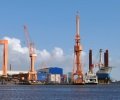

Daehan Shipbuilding in Haenam, South Jeolla Province, was building two large tankers side by side inside a dry dock early on June 25. Nearby, workers were making ship blocks for other vessels. With a three-year order backlog worth about 3 trillion won ($2.2 billion), the shipyard is running at full capacity to meet deadlines. Last year, Daehan led the global medium tanker market with a 14% share and posted an operating margin of 14%—a rare achievement in shipbuilding. The company credits its fully in-house production system, which covers all processes from steel treatment to block assembly.
K Shipbuilding, a mid-sized shipbuilder based in Jinhae, South Gyeongsang Province, recorded an average operating rate of 110% in the first quarter of the year. Last year’s annual average was already high at 93%, but activity increased further this year. An operating rate above 100% indicates production continued during nights and weekends. Thanks to nonstop operations, the company’s first-quarter revenue rose 22.7% to 285.6 billion won, and operating profit jumped 404.9% to 12.7 billion won compared to the same period last year.
South Korea’s mid-sized shipbuilders, once on the brink of collapse after a prolonged industry slump, are making a comeback. The sector, which once included more than 20 companies, has now been consolidated into four main players: Daehan Shipbuilding, HJ Shipbuilding & Construction (HJSC), K Shipbuilding, and Daesun Shipbuilding. All four posted operating profits in the first quarter of this year. For three of them, excluding Daesun, it was the first time in 14 years that they all turned a profit at the same time. As the backbone of South Korea’s shipbuilding industry with around 10,000 employees, these companies’ revival is revitalizing regional economies.
Their recovery followed painful restructuring through corporate workouts. They scaled back from container ships, which were vulnerable to low-cost competition from Chinese yards, and instead focused on tankers, chemical carriers, and patrol vessels where they held a competitive edge.
HJSC, based in Busan and formerly known as Hanjin Heavy Industries, has found new momentum in naval defense, a rising strength in South Korea’s shipbuilding sector. Once ranked among the global top six after expanding to Subic Bay in the Philippines, the company was hit hard by the industry slump in the 2010s. After emerging from five years of court-led restructuring in 2021, it refocused on military vessels and eco-friendly ships, targeting niche markets that avoid direct competition with major shipyards and offer differentiation from Chinese players.
At the MADEX maritime defense exhibition held in Busan last month, HJSC displayed a range of vessels including the Marado and Dokdo transport ships, high-speed landing craft (LSF-II), missile patrol boats (PKG), and a 3,000-ton coast guard vessel. Countries such as the UAE and Egypt showed strong interest, with some delegations visiting the company’s Yeongdo shipyard.
K Shipbuilding’s recovery has been driven by chemical tankers. As the war in Ukraine redirected petrochemical transport from pipelines to sea routes, ship prices surged. The company has delivered over 240 MR tankers to date and recently handed over its first LNG dual-fuel carrier, strengthening its push into the eco-friendly vessel market.
Daesun Shipbuilding, the smallest of the four mid-sized players, is in its third year of restructuring. It mainly builds small- and mid-sized container ships and bulk carriers, but earlier low priced contracts have weighed on its profitability. The company plans to clear out these orders within the year and accelerate structural reform. After narrowing losses in recent years, Daesun posted a first-quarter operating profit of 1.2 billion won. It is eyeing the naval maintenance, repair, and overhaul (MRO) business to drive future growth.
Source: The Chosun Daily